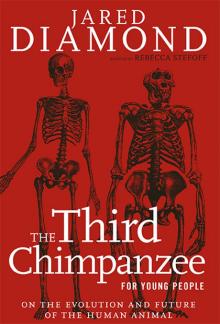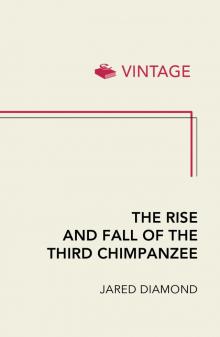- Home
- Jared Diamond
The Third Chimpanzee: The Evolution and Future of the Human Animal Page 2
The Third Chimpanzee: The Evolution and Future of the Human Animal Read online
Page 2
Each chain is made up of four types of small molecules. The sequence, or order, of those small molecules carries all the genetic information that is passed from parents to offspring.
To measure changes in DNA structure, scientists use a method called DNA hybridization. They mix the DNA from two species, then measure the melting point of this mixed, or hybrid, DNA. The next step is to compare the melting point of the hybrid DNA with the melting point of pure DNA from a single species. A difference of about one degree centigrade means that the two species differ by about 1 percent of their DNA.
The final stage is to calibrate, or set, the DNA clock. This means linking DNA change to the passage of time. We might know that two species’ DNA differs by 1 percent, but until we know how DNA changes over time, we can’t know how long the two species have been evolving separately. To calibrate the DNA clock, scientists use species whose evolutionary history is known from fossils that can be accurately dated. In the case of birds, studies of both fossils and DNA from living bird species reveal that one gene in DNA (the gene called cytochrome b) appears to change by 1 percent every one million years. Using this information, scientists can measure the differences in cytochrome b in any two living bird species and tell how long ago those species separated from the ancestor they shared.
A key to understanding connections among living things lies in DNA, the genetic material within our cells. It is made up of two long strands of molecules linked by shorter pairs of molecules, like a ladder with many rungs that has been twisted into a spiral—a shape known as a double helix.
FIGURE I
A family tree of evolutionary relationships among primates, including humans. Black dots represent the last time two groups shared the same ancestor. The scale on the right measures time and the scale on the left measures differences in the DNA of living species. Start with the dot on the bottom right—that’s the point, more than 30 million years ago, when apes separated from the monkeys of Eurasia and Africa. The monkeys kept evolving right up to the present. As the apes evolved, gibbons split off into their own line about 20 million years ago. The black dot marking that split is at 5 percent on the DNA scale, because gibbons differ in 5 percent of their DNA from other apes and humans. The second black dot from the left shows humans and chimpanzees splitting about 7 million years ago, with a difference of less than 2 percent in the DNA of humans and chimpanzees today.
The Primate Family Tree
When scientists studied the molecular clock in primate DNA, they found that the biggest genetic difference is between monkeys on one hand and apes and humans on the other. This came as no surprise. Ever since apes became known to science, everybody has agreed that humans and apes are more closely related to each other than either of them is to monkeys. The molecular clock showed that monkeys differ from humans and apes in 7 percent of their DNA structure.
The clock also confirmed that gibbons are the most distinct apes. They differ from the other apes and humans in 5 percent of their DNA structure. Orangutans differ in 3.6 percent from gorillas, chimpanzees, and humans. These findings show that gibbons and orangutans separated from the rest of the ape family long ago. Today, gibbons and orangutans are found only in Southeast Asia. In contrast, gorillas and chimpanzees are found only in Africa, which was also the home of the earliest humans. Among apes, the most closely related living species are the two types of chimpanzees, common chimps and bonobos. Their DNA is 99.3 percent identical.
What about humans? We differ from gorillas in about 2.3 percent of our DNA, and from chimps of both species by about 1.6 percent. This means that we share 98.4 percent of our DNA with chimpanzees, our closest living relatives. Put another way, the chimpanzee’s closest relative is not the gorilla—it is the human.
Calibrated for primate species, the DNA clock shows that gorillas separated from the line leading to chimps and humans about ten million years ago. Ancestral humans separated from chimps about seven million years ago. in other words, humans have been evolving on their own for something like seven million years.
The genetic distance separating us from chimps is less than the distance between two species of gibbons (2.2 percent). in an example from the bird world, the red-eyed vireo and white-eyed vireo are species of songbirds. Both belong to the same genus, or cluster of closely related species. But they differ in 2.9 percent of their DNA—much more than the difference between us and chimps. in terms of genetic distance, humans, common chimps, and bonobos should be grouped in the same genus. Looked at this way, humans are a third species of chimpanzee.
HOW SHOULD WE TREAT APES?
NOW THAT WE KNOW HOW SMALL A GENETIC distance separates us from chimps, our ideas about the places of humans and apes may change over time. One area that might change is the way we treat apes. Ethical issues—that is, questions of what is right and wrong—are involved.
It’s considered acceptable to exhibit caged apes in zoos, but it’s not acceptable to do the same thing with humans. Yet if it were not for the interest in apes that many people gain by visiting zoos, the public might contribute much less money to protect apes in the wild. How will we balance our desire to collect chimpanzees and other apes in zoos with our knowledge that we are so closely related to chimps?
Medical experimentation on chimpanzees is a controversial subject. It is unethical, or wrong, to perform experiments on humans without their knowledge and consent. Why is it okay to perform such experiments on chimps? If we say it is because chimps are animals, then we are saying they are no different from insects and bacteria in terms of what we can do with them, because insects and bacteria are also animals. But if we consider intelligence, social organization, and the ability to feel pain, it becomes hard to draw an all-or-nothing line between all humans and all animals. Instead, different ethical rules should apply to research on different species. If there is any animal species now used in medical research for which we could argue that all experimentation should stop, that species is surely the chimpanzee.
Making matters worse, chimps used for research are often caged under cruel conditions. The first research chimp that I saw had been injected with a slow-acting deadly virus. It was being kept alone for several years, in a small indoor cage, with nothing to play with, until it died. And the capture of wild chimps for research usually means that several wild chimps are killed to capture one, which is often a youngster being carried by its mother.
Yet the very reason medical researchers use chimps is that they are so genetically similar to us. Experiments on apes are a far better way to improve medical treatments than experiments on any other animals. Researchers are now studying certain diseases in captive chimps. How would we explain to parents whose children are at risk of dying from those diseases that their children are less important than chimps? Ultimately, we the public, not just scientists, will have to make these terrible choices. Our view of man and apes will determine our decision.
The Differences between Chimps and Humans
How could just 1.6 percent of genetic difference change chimpanzees into humans? Exactly which genes changed? To answer those questions we need to understand what DNA, our genetic material, does.
Much of our DNA has no known function. Of the DNA that does have known functions, the main functions have to do with proteins, which are long chains of amino acids. Parts of our functional DNA govern the creation of proteins. It works this way: The sequences of small molecules in our DNA specify, or direct, the order of amino acids in our proteins. Certain proteins make up our hair and tissue, while other proteins are enzymes that make and break down the other molecules in our bodies.
The genetic features that are easiest to understand arise from single proteins and single genes, or chunks of DNA. For example, our blood’s oxygen-carrying protein, hemoglobin, is made of two amino acid chains, each specified by a single gene. But other genes influence more than one trait. For example, the fatal genetic disease Tay-Sachs causes many visible traits: drooling, abnormal skull growth, yellowish
skin, and more. We know that all these effects come from changes in a single enzyme specified by the Tay-Sachs gene, but we don’t know how.
Scientists understand the functions of many individual genes that specify individual proteins, but we know much less about how genes shape complex traits, such as behavior. Human hallmarks—that is, characteristics that distinguish us as human—such as art, language, or aggression, are not likely to depend on a single gene. in addition, human behavior is influenced by family, culture, nutrition, and other aspects of each person’s environment. it’s very controversial what role genes play in the individual differences among humans. But for differences in behavior between all chimpanzees and all humans, genetic differences are likely to play a role.
The ability of humans but not chimps to speak, for example, must be related to differences in genes that specify the structure of the voice box (larynx) and the wiring of the brain. A young chimpanzee that was raised in a psychologist’s home along with the psychologist’s daughter of the same age didn’t learn to speak or walk upright, although the girl did. Humans grow up to speak, no doubt because of our genetic program. But whether an individual human grows up to speak english or Korean has nothing to do with genes. it depends on what languages the growing child hears spoken.
We don’t yet know which chunks of our DNA are responsible for the significant differences between humans and chimps that are covered in the next four chapters. All we can say for sure is that those differences must come from some part of 1.6 percent of our genes. We do know that just one or a few genes can have big impacts. The many big, visible differences between Tay- Sachs patients and those without the disease come from one change in one enzyme.
Cichlid fish, popular for aquariums, also show the impact of small genetic changes. Africa’s Lake victoria has about two hundred species of cichlids. All of them evolved from a single ancestor over a period of about two hundred thousand years. These species differ in their food habits as much as tigers and cows do. Some cichlids graze on algae, some catch insects, some nibble the scales off other fish, some crush snails, and some snatch fish embryos from mother fish. Yet all those species differ from one another by less than half of 1 percent of their DNA. it took fewer genetic mutations to turn a snail crusher into a baby snatcher than it took to produce us from an ape.
Horses, bulls, deer, and other animals leap and run on the walls of a set of caves in Lascaux, in southern France. Created by people of the Late ice Age, around seventeen thousand years ago, the prehistoric artworks of Lascaux became known to the modern world in 1940, when four teenage boys discovered and explored the caves.
CHAPTER 2
THE GREAT LEAP FORWARD
FOR MOST OF THE MILLIONS OF YEARS SINCE the human line separated from the apes, we remained little more than glorified chimpanzees. As recently as sixty thousand years ago, western europe was still occupied by Neanderthals, a human species that scarcely knew of art or progress. Then came an abrupt change. Anatomically modern humans—that is, people who looked like us—appeared in europe, bringing with them art, musical instruments, trade, and progress. Soon the Neanderthals were gone.
If there is any one time when it could be said that we became human, it was at the time of that Great Leap Forward, sixty thousand years ago. That leap was probably the result of another leap that took place in Africa and the Middle east. That earlier leap spanned a few tens of millennia. (One millennium is a thousand years; ten millennia is ten thousand years.) even several dozen millennia, though, is a tiny fraction, less than 1 percent, of our long history apart from ape history.
After the Great Leap Forward, we were only a few dozen millennia from domesticating animals, developing agriculture and metalworking, and inventing writing. From there it was a short step to the monuments of civilization, such as the Mona Lisa, Beethoven’s symphonies, the eiffel Tower, the international Space Station, and weapons of mass destruction.
What made our sudden, steep rise to humanity possible? What held back the Neanderthals, and what was their fate? Did two species of humans ever meet, and how did they behave toward each other? in short, what made us human, and why did our particular branch on the family tree, Homo sapiens, become the last humans standing?
Becoming Human
Life on earth originated several billion years ago. Dinosaurs became extinct about sixty-five million years ago. it was only between ten and six million years ago that our ancestors became distinct from the ancestors of chimpanzees. Human history is just a tiny percentage of the history of life. Science fiction films that show cavemen running from dinosaurs are just that: science fiction.
The shared ancestor of gorillas, chimps, and humans lived in Africa. Gorillas and chimps are still found only in Africa, and humans remained confined there for millions of years. At first our own ancestors would have been classified as just another species of ape, but a series of three changes launched us in the direction of modern humans.
The first change occurred about four million years ago. Fossils from that time show that our ancestors were regularly walking upright on two legs, unlike gorillas and chimpanzees, which usually walk on four legs and only occasionally on two. When our ancestors began walking upright, their front limbs were freed to do other things—most important, to make tools.
The second change occurred around three million years ago. All modern humans belong to the same species, Homo sapiens, but on perhaps several occasions in the past, our lineage—that is, the line of descent leading from our ancestors to us—split into at least two species that lived at the same time. Around three million years ago, our lineage divided into two species. One was a man-ape with a heavy skull and big side teeth. it probably ate coarse plant food. We call that species Australopithecus robustus, “the robust southern ape.” The other was a man-ape with a thinner, lighter skull and smaller teeth. it probably ate a wide variety of foods. it is called Australopithecus africanus, “the southern ape of Africa.”
Australopithecus africanus evolved into a larger- brained form called Homo habilis, “man the handyman.” But Homo habilis was not the only branch of our family tree living in Africa several million years ago. We now have fossil evidence that several different species of protohumans, or early forms of humans, existed at that time and place.
The third big change that made our ancestors more human and less apelike was the regular use of stone tools. This is a human trait with clear origins in the animal world. Woodpecker finches, egyptian vultures, and sea otters are among the other animals that evolved to use tools such as stones or twigs to capture or process food. None of them, though, depend on tools as much as we do.
Common chimpanzees also occasionally use tools, including stone tools, but not so many as to litter the landscape. But by around two and a half million years ago, very crude stone tools appear in large numbers in parts of east Africa where protohumans lived. Since there were multiple protohuman species, who made the tools? Most likely the earliest tools were made by the one protohuman species that survived and kept evolving.
Shakedown in Africa
With two or three protohuman species living in Africa at the same time, but only one human species surviving today, it’s clear that some species must have become extinct. Which species survived to become our ancestor?
The winner was the light-skulled Homo habilis, who went on to increase in brain size and body size. By 1.7 million years ago enough differences had appeared that scientists give our lineage a new name: Homo erectus, “upright-walking man.” (Homo erectus fossils were found before all the older fossils i’ve mentioned, so the scientists who named this species didn’t yet know that earlier protohumans also walked upright.) Meanwhile, the lineage ofAustralopithecus robustus, the “robust man-ape,” disappeared sometime after 1.2 million years ago. Other protohuman species, if any, must have died out around the same time.
Why did the robust man-ape and other protohumans go extinct? Perhaps they could no longer compete with Homo erectus, who ate both me
at and plants and had tools and a larger brain. it’s also possible that Homo erectus gave his relatives a push toward extinction by killing them for meat.
The shakedown in Africa left Homo erectus as the only protohuman on the stage. By that time Homo erectus had already expanded his horizons, starting around two million years ago. His stone tools and bones show that he reached the Middle east, then east Asia. He continued to evolve in our direction, developing a larger brain and a rounder skull. By about half a million years ago, some of our ancestors looked enough like us, and enough different from Homo erectus, that they are classified as our own species, Homo sapiens, even though they had thicker skulls and heavier bony eyebrow ridges than ours.
Wasn’t the appearance of Homo sapiens half a million years ago a Great Leap Forward? Not at all. it was a nonevent. Cave paintings, houses, and bows and arrows still lay hundreds ofthousands ofyears in the future. Stone tools continued to be the same crude ones that Homo erectus had been making for nearly a million years. The extra brain size of early Homo sapiens had no dramatic effect on our way oflife. Our rise to humanity was not in direct relation to the changes in our genes. Some vital ingredient still had to be added before the third chimpanzee could come up with the idea of painting the Mona Lisa.
FIGURE 2
The many-branched human family tree reminds us that for long stretches of prehistory we shared the world with other human species.Our hominid ancestors began evolving separately from apes around 7 million years ago. By 4 million years ago some hominids walked on two legs. Around 3 million years ago, the human line split into two branches, Australopithecus africanus and A. robustus. The A. robustus line died out. The A. africanus line split into branches of its own. The Homo habilis branch led to Homo erectus and later Homo sapiens. (Fossils suggest that another branch of A. africanus, sometimes called the “Third Man,” lived in Africa before dying out.) The H. sapien line eventually split into three branches. One branch led to anatomically modern humans in Africa and on to today’s global human population. One branch led to the Neanderthals, who became extinct. Scientists are29 just starting to piece together the history of the third, Asian branch.

 Why Is Sex Fun?: The Evolution of Human Sexuality
Why Is Sex Fun?: The Evolution of Human Sexuality Guns, Germs, and Steel: The Fates of Human Societies
Guns, Germs, and Steel: The Fates of Human Societies Collapse: How Societies Choose to Fail or Succeed
Collapse: How Societies Choose to Fail or Succeed The Third Chimpanzee: The Evolution and Future of the Human Animal
The Third Chimpanzee: The Evolution and Future of the Human Animal The World Until Yesterday: What Can We Learn From Traditional Societies?
The World Until Yesterday: What Can We Learn From Traditional Societies? The Rise and Fall of the Third Chimpanzee
The Rise and Fall of the Third Chimpanzee Upheaval: Turning Points for Nations in Crisis
Upheaval: Turning Points for Nations in Crisis Guns, Germs, and Steel
Guns, Germs, and Steel The Third Chimpanzee for Young People
The Third Chimpanzee for Young People Why Is Sex Fun?
Why Is Sex Fun?